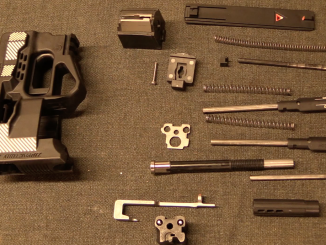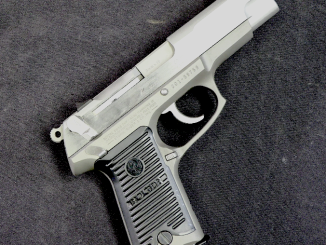The Smith-Jennings rifles are one of the evolutionary steps towards the revolutionary Henry and Winchester lever-action rifles. Here is the rifle that brought together the ideas of Hunt (who invented the rocket ball cartridge) and Jennings with the men who would go on to develop the gun into its final form – Henry, Smith, and Wesson.
Related Articles

Prototype
Pedersen Selfloading Rifle at RIA

Semiauto pistol


“revolutionary”
Why they were revolutionary? I rather believe in mechanics it is always evolution not revolution, even if it sometimes slower or faster.
That’s a good and entirely fair question.
Spring-driven tubular magazines for round ball were used on repeating air-rifles in Europe half a century earlier.
Self-contained combustible cartridges were a feature of the Colt percussion revolvers going back to 1846.
The lever-action breech was already being used by Christian Sharps on his early “slant breech” breechloader.
And even the “pill lock” automatic percussion-ignition feed wasn’t all that new. Both Alexander Forsyth and Joshua Shaw had patented versions of it in the 1820s and ’30s. Maynard’s “tape primer” (the ancestor of the 20th Century childrens’ “cap pistol” feed) was as much as anything else a way to get around the Shaw patent.
Jennings put it all together in one package. He only fell down in one area; the self-contained ammunition he developed didn’t effectively seal the breech against gas escape, and also couldn’t deliver much in the way of hitting power.
The Jennings “Volitional Repeater” was more of a proof-of-concept item than an actual, practical weapon system. The successor Volcanic system arms were a step on the road to making it a serious weapon.
The Henry and Winchester, with self-contained metallic cartridges in first rimfire and then centerfire, made it a viable combat weapon.
The Henry and the similarly-conceived but simpler Spencer, firing “intermediate-power” ammunition at (for the time) very high RoFs out to maximum practical engagement ranges of 200 to 300 yards, were in a very real sense the “assault rifles” of the American Civil War, and repeated that performance at places like Plevna a decade later.
After which, the tubular magazine lever-action rifle’s evolution as a sporting and personal defense/survival arm was pretty much a foregone conclusion. It had proven it could do the job in the most hostile environment most people could imagine; on the battlefield.
cheers
eon
Considering that this underpowered weapon is a transition between the single-shot muzzle loader and the cartridge firing repeater, it is understandable that several things went wrong (reliability and complexity). In fact, one might think that the combustible paper cartridge for the Podewils-Lindner conversion rifled musket was a better idea, if only because it could be stuffed into the breech as a single packet (although you still needed a percussion cap placed on the nipple) and still have enough oomph to wreck two watermelons placed one behind the other. Metallic cartridges ultimately were the way to go, as they could contain primer, propellant, and projectile all in a single package. The issue was which metal to use, and eventually brass came out on top in terms of being inexpensive.
Did I mess up?
Note that metallic cartridge important role was to seal – prevent gas escape/leaks.
“Metallic cartridges”
See disruptive innovation
“paper cartridge”
and it was also cheaper
Thanks Ian, another informative vid. BEAUTIFUL mechanics on that piece. Intersting to see the earlier forms of what became standard later on the Henry.
I wonder what would have happened to firearms technology if nitrocellulose had been invented in the early nineteenth century.
Given that, unlike black powder, it can made into a moldable hard plastic we could have had a generation of caseless lever guns during and after the civil war.
Yes, I’m quite sure that wouldn’t be inconvenient for the troops, had the processing for making nitrocellulose not involved horrifically expensive chemistry not accessible to the general public! And how do you stick the propellant to the bullet and primer unless you want paper casing?
Caseless ammo still hasn’t been solved reliably for small arms.
Breech sealing and ammunition durability in transit and storage being the main hurdles that have as yet not been gotten over.
A more likely solution (that could actually have been made in the 19th Century) is Combustible Plastic Cased Telescoped Ammunition (CPCTA). A typical shotgun shell is a good example of how it is laid out, but a true PCTA round does not have a brass “head”.
Making the case combustible would have been no great trick in the mid-19th Century, as here;
http://www.madehow.com/inventorbios/93/John-Wesley-Hyatt.html
Hyatt’s “celluloid”, the first artificial industrial plastic, was made by dissolving camphor in alcohol. Interestingly enough, when struck a sharp blow, it sometimes “fired” with a sharp “crack”. Considering that the first use of it (in 1869) was making billiard balls, one can only imagine the result of such a gunshot-like sound in a billiard hall in, say, Tombstone, Arizona.
That same attribute would have made Hyatt’s celluloid, in a more combustible mixture, an entirely viable material for a combustible plastic-cased cartridge, either with black powder or smokeless powder.
The idea of a “telescoped” round would not have seemed strange at the time; all “paper” cartridges for muzzle-loaders were by definition “telescoped” rounds, and of course there was the already-existing shotgun shell that had been around since the 1830s. (See; Clement Pottet, Jean Samuel Pauly.)
Among other things, it would have been the answer to Colt’s prayers, as not only a way around the Rollin White patent on the bored-through cylinder (a more efficient Thuer conversion that would not need the cranky ejector most of the time), but also as an improvement on Colt’s other “bread and butter” military catalog item, the Gatling gun. By eliminating about half the operating cycle (ejection) except for duds which would just get cycled through, celluloid-cased combustible rounds would have significantly increased the Gatling’s rate of fire because being lighter they would be more easily handled by the feed systems of the time without jamming. Coupled with an electric motor (an experiment Gatling made as far back as 1885), they would have given the Gatling of a century or more ago a fearsome rate of fire, nearly that of modern “Vulcan” type versions.
I don’t know if a CPCTA lever-action would be practical: I’d expect breech-sealing problems unless some sort of “stub” head were used as with the modern 120mm Rheinmetall gun on the M1A3 Abrams MBT.
But for any sort of “front-loader”, or a very high RoF weapon like a Gatling, Gardner, or etc., it would very likely have looked very interesting to the ordnance experts of the day.
cheers
eon
“very high RoF weapon”
It might look good, but it is hard to do in reality.
Material used must flame very fast – it must disappear BEFORE next round will be rammed into chamber, if this is not true it might either jam or next round might fire BEFORE weapon fully closed (set to fire be still flaming case of previous round)
Good points. Caseless/combustible case ammo remains appealing today.
Another problem with caseless ammo is gas cutting of the chamber. Imperfections in the ammo surface concentrate the combustion into an intense jet which erodes the chamber. Somewhat analogous to a shaped charge. IIRC experiments were carried out with ammo that had lot numbers pressed into the sides. After firing the lot numbers had been etched onto the chamber walls.
The earliest British .303 ammo was made with black powder as they worked on a choice for their new smokeless powder before deciding on cordite. The black powder was pressed into a pellet and inserted into the case before neck forming. Presumably there would have been gas cutting in that situation, except on the insides of the case and not the chamber.
That was the case with Minnie shot, minus nitrocellulose powder; was it not?
This gun in its own wrights is an exciting enough not to mention its following lineage going all the way to late S&W lever actions. Superb discovery and its historical background presentation!
The “genealogy” of this rifle goes something like this:
US5701 ; August 10, 1848 ; Walter Hunt ; “rocket ball” patent
US6663 ; August 21, 1849 ; Walter Hunt ; repeating firearm for the above (patented in England December 10, 1847)
US6973 ; December 25, 1849 ; Lewis Jennings ; patent for the Jennings improvement of the above
US8317 ; August 26, 1851 ; Horace Smith ; patent for the “Smith” part of the Smith-Jennings improvement (said to have been suggested by Smith’s employee B. Tyler Henry)
Looking at those hooks on the locking block and the pivoted lever of the “Smith” improvement remind me of the current Marlin lever-action system. ^__^